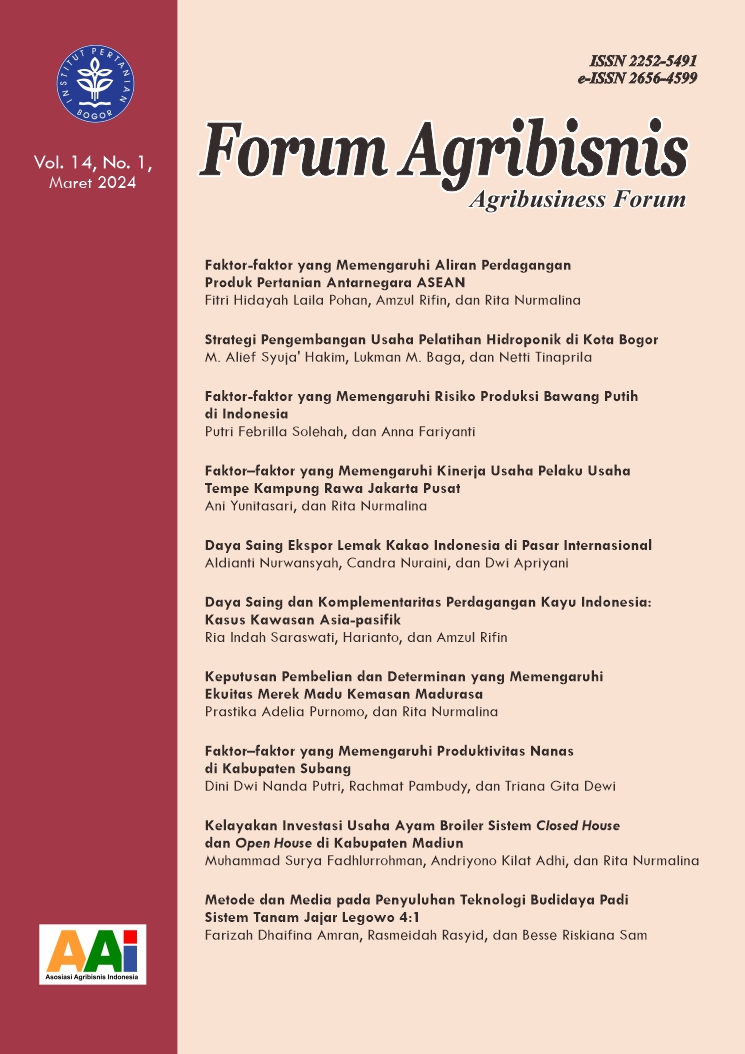Daya Saing Ekspor Lemak Kakao Indonesia Di Pasar Internasional
Main Article Content
Abstract
International trade can be defined as trade transaction activities, carried out by citizens of a country and foreign nationals based on mutual agreement. Cocoa is one of the leading commodities struggling for export. Indonesian cocoa exports have changed in composition, cocoa butter contributes the largest export when compared to exports of other Indonesian processed cocoa products. The increasing world cocoa consumption will be an opportunity for Indonesia to increase cocoa butter exports. This study aims to: (1) Analyse the competitiveness of Indonesian cocoa butter exports in the international market based on comparative advantages. (2) Analyse the competitiveness of Indonesian cocoa butter exports in the international market based on competitive advantages. The object of this study focuses on the position and competitiveness of Indonesian cocoa butter exports in the international market by comparing the largest exporting countries on cocoa butter (HS 1804). The analysis methods used in this study were RCA, Product Mapping, and ECI The results of RCA analysis showed that Indonesian cocoa butter exports have comparative advantages and based on Product Mapping analysis, Indonesian cocoa butter exports are in group A, which means they have comparative advantages and export specialization. The results of the ECI analysis showed that cocoa butter exports have a competitive advantage and showed that Indonesia's cocoa butter exports have an upward trend. Indonesia has the opportunity to become a major country in dominating the cocoa butter market in the international market both in terms of comparative and competitive advantages. For this reason, in increasing competitiveness, efforts are needed to improve the quality of cocoa beans so that it will have an impact on the downstream industry, one of which is cocoa butter. There is also a need for further analysis of what factors affect the export of cocoa butter in Indonesia and its competitors.
Downloads
Article Details

This work is licensed under a Creative Commons Attribution-ShareAlike 4.0 International License.
The author submitting the manuscript must understand and agree that the copyright of the article manuscript must be submitted/transferred to the Journal Forum Agribisnis. This work is licensed under the Creative Commons Attribution-ShareAlike 4.0 (CC BY-SA) International License in which the Author and Reader can copy and redistribute the material in any media or format, and remix, modify and build material for any purpose, but they must provide appropriate credit (citing articles or content), provide a link to the license, and indicate whether there is a change. If you mix, change, or create material, you must distribute your contribution under the same license as the original.
References
Amanda,S. dan Rosiana, N. 2023. Analisis Daya saing Kopi Indonesia dalam Menghadapi Perdagangan Kopi Dunia. Forum Agribisnis (Agribusiness Forum), 13(1): 1-11. https://doi.org/10.36841/agribios.v21i1.2807
Andini, D., Yulianto, E., & Fanani, D. 2016. Peningkatan Daya Saing Ekspor Produk Olahan Kakao Indonesia di Pasar Internasional (Studi pada Ekspor Produk Olahan Kakao Indonesia tahun 2009-2014). Jurnal Administrasi Bisnis S1 Universitas Brawijaya, 38(2): 171–175.
Badan Penelitian dan Pengembangan Pertanian, D. Pertanian. J. B., Pengembangan, P. dan, & Pertanian, D. Pertanian. 2005. Prospek dan Arah Pengembangan Agribisnis Kakao Indonesia.
Balqis, P. dan Yanuar, R. 2021. Daya Saing Kesport Lada Indonesia di Pasar Amerika dan Eropa. Forum Agribisnis. 11(2): 182-194. https://doi.org/10.29244/fagb.11.2.182-194
Basri, F., & Munandar, H. 2010. Dasar-Dasar Ekonomi Internasional: Pengenalan dan Aplikasi Metode Kuantitatif. Jakarta (ID): Kencana.
Febri K. P. & Meydianawathi L. G. 2014. Analisis Tingkat Daya Saing Ekspor Biji Kakao Indonesia Tahun 2007-2012. E-Jurnal EP Unud, 3(11): 502–512.
Ginting, N. M., Rahmanta, R., & Lindawati, L. 2021. Analisis Daya Saing Kakao Olahan dan Faktor-Faktor yang Mempengaruhi Daya Saing Kakao Olahan Provinsi Sumatera Utara, Indonesia di Pasar Internasional. Agro Bali: Agricultural Journal, 4(3): 425–437.
Halwani, H. 2010. Ekonomi Internasional Teori dan Kebijakan Perdagangan Internasional. Bogor: Ghalia Indonesia.
Hanafi, R. U., & Tinaprilla, N. 2017. Daya Saing Komoditas Kakao Indonesia di Perdagangan Internasional. Forum Agribisnis, 7(1): 1–20. https://doi.org/10.29244/fagb.7.1.1-20
Hayati, R., Yusmanizar, Y., Mustafril, M., & Fauzi, H. 2012. Kajian Fermentasi dan Suhu Pengeringan pada Mutu Kakao (Theobroma cacao L.). Jurnal Keteknikan Pertanian, 26(2): 129–135.
Kusuma, R. L., & Firdaus, M. 2015. Daya Saing dan Faktor yang Memengaruhi Volume Ekspor Sayuran Indonesia Terhadap Negara Tujuan Utama. Jurnal Manajemen Dan Agribisnis, 12(3): 226-236. https://doi.org/10.17358/jma.12.3.226
Langkong, J. 2012. Pemetaan Lemak dari Biji Kakao (Theobroma cocoa L) di Sulawesi Selatan.
Laursen, K. 2015. Revealed comparative advantage and the alternatives as measures of international specialization. Eurasian Business Review, 5(1): 99–115. https://doi.org/10.1007/s40821-015-0017-1
Lindung, & Jamil, A. S. 2018. Posisi Daya Saing dan Tingkat Konsentrasi Pasar Ekspor Karet Alam Indonesia di Pasar Global. Jurnal AGRISEP : Kajian Masalah Sosial Ekonomi Pertanian Dan Agribisnis, 17(2): 119–128. https://doi.org/10.31186/jagrisep.17.2.119-128
Purba, B., Purba, D. S., Purba, P. B., Nainggolan, P., Susanti, E., Damanik, D., Parinduri, L., Lie, D., Fajrillah, F., & Rahman, A. 2021. Ekonomi Internasional. Yayasan Kita Menulis.
Syadullah, M. 2015. Dampak Kebijakan Bea Keluar Terhadap Kinerja Industri Pengolahan Kakao. Buletin Ilmiah Litbang Perdagangan, 6(1): 53–68. https://doi.org/10.31543/jii.v1i1.54
Tambunan, T. 2001. Perdagangan Internasional dan Neraca Pembayaran. PT Pustaka LP3ES. Jakarta.
Tresliyana, A., Fariyanti, A., & Rifin, A. 2015. Daya Saing Kakao Indonesia di Pasar Internasional. Jurnal Manajemen Dan Agribisnis, 12(2): 150–150. https://doi.org/10.17358/jma.12.2.150
Widodo, T. 2009. Comparative Advantage: Theory, Empirical Measures and Case Studies. Review of Economic and Business Studies (REBS), (4): 57–82.

